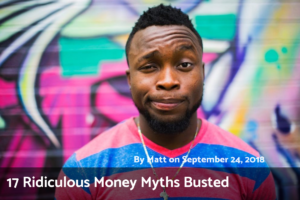Starting a podcast seemed like a complicated task when I first tried many months ago. There are so many posts and even podcasts about podcasting the whole process was confusing. I didn’t know which host to use, what name to go by, or even how to record a podcast. Until recently, I had almost given up the idea of ever trying to host a podcast. This is because the good folks at Anchor have made starting a podcast so, so easy. Since 2014, Anchor has been working and developing this amazing way for you to enter the world of podcasting with very little money needed. If you’re considering trying your hand at podcasting, then you’ll want to check out this guide on how to start a podcast with Anchor and do it for FREE.
Sign Up
First you’ll want to go to Anchor.fm or download the Anchor app and sign up for an account using Gmail, Facebook, Twitter, or through Anchor’s “Sign Up” link. Hopefully you already have a name for your podcast. If not, don’t worry and begin brainstorming right now. Use Google Sheets or Excel and just put all the potential names of the podcasts and topics you want to cover in there.
Write a Good Description
Write a good description for your podcast, because this is what all the other podcast players will display for you. Your listeners and fans will read this description to learn more about you and the podcast. You will want us as much information about your podcast and the topics you cover in the description as you start a free Anchor hosting podcast.
Podcast Cover Art
For your Podcast cover art use Canva. Canva is a great place where you can design your cover art for free. Make sure you select the “Album Cover” design. Your podcast cover art needs to be 3000 x 3000 pixels. You want this size, because your cover art needs to look good and legible on any device. Your cover art will be viewed in podcast players on smartphones, tablets, computers so it’s important to create a cover art 3000 x 3000 pixels. Try to not spend so much time on this. You’ll be able to edit your podcast cover art anytime in the future and besides you need to start recording!
Recording Your Episodes
Once you’ve logged in, Anchor makes it very easy for you to start recording your first episode. You’ll need one episode before you can submit your podcast to Apple, Google and other podcast players. However, I recommend recording 3-5 episodes as you start your free Anchor podcast. Then backdate the episodes based on the frequency you plan to release a new episode, like once every week, two weeks or a month. I created the Habesha Finance Podcast with 3 episodes and simply chose the previous 3 Mondays to reflect my once a week schedule.
Now it’s time to record your first episode of what will be an awesome podcast. Here are some helpful tips when recording:
- You don’t need expensive equipment when you first begin. Personally, I’ve been testing my iPhone and it seems to work for now. You can also go for a cheap, very good mic device with the Logitech USB Headset H390 with Noise Cancelling Mic. If you absolutely want better quality, then go for the Blue Yeti USB Microphone. Personally, I have the Rode NT1-A and recording with this microphone sounds very good. This mic is definitely the most expensive of the three mics to purchase. With the Rode NT1-A you’ll need to buy a separate mixer and this all can very expensive very fast. These three mics have been reviewed and researched by podcasters all over and you have access to read all those reviews with Google. I feel that if you’re going to start a free Anchor podcast then you should try using your phone first and upgrade later on.
- Record in a quiet place. I like the closet, because the coats, dresses and other clothes in our closet helps with sound quality. If your podcast is one that depends on outside setting or some background noise then just make sure you can be heard with each recording. This may require you to get a portable recording device.
- Have your show transcript already written so the show can flow. Read over your transcript one time before you start recording so you can be confident in what you’re about to read.
- If you mess up in the middle of a recording, don’t worry. Just record a new segment a few seconds before where you left and you’ll be able to edit the clips after.
- When editing the clips use Audacity or GarageBand. Personally I like Audacity…it’s simple and fast to use. This is where you can edit those mistakes out to make your podcast sound smooth and clean. For tips on how to use Audacity, there are Youtube videos available out there.
Submit Your Podcast
So, now you’ve created your first 3 episodes and you’re ready for the world to hear you right? Not so fast buddy. This is going to take time. Getting approved for various podcasts will take time, like 1-5 days typically. Anchor can automatically submit your podcast to Apple and some other players which is the route I suggest you take. However, when it comes to Stitcher or Google Play you’ll need to get your RSS URL and manually submit that to those other players. The RSS URL can be found in your Anchor.fm Settings page. You’ll most likely need to create accounts with Google and Stitcher, but that takes no time. You can visit my Podcast page to see how I combined all the approved podcast players onto one page on my site.
Monetizing with Anchor
Monetizing your podcast is a great way to generate income. I don’t recommend monetizing initially, but that’s up to you. I personally feel monetizing a podcast should be done after you’ve provided value and built an audience. It doesn’t have to be a huge audience. I’m just thinking many of you will be disappointed if you’re only making a few cents here and there. So, do what you want and I hope at least you’ll see as I’ve seen it’s hard to make a living off of podcasting right away. You’re going to have to put in the work and be patient over the years.
What’s Next
After your podcast has been approved to the various players you need to get the word out. You can promote to family and friends and kindly ask for their support. There are Facebook groups you can join to learn and grow your podcast. There’s a great Facebook group dedicated to Anchor podcasters where you can get help with your podcast and promote it. There are also links you can share on social media and text messages for others to listen to your podcast. This is why it’s important to have your podcast approved on various platforms. Starting a podcast is just the beginning and now you have to learn to market your podcast.
Last Minute Tips
Remove the Anchor logo
If you want to remove the Anchor logo from your podcast cover art then be sure to deselect “Anchor logo on cover art” under settings. I like this feature, because you really get to create your own podcast cover art to show the world. Nothing extra or anything covering your cover art.
Anchor post-roll in episodes
Same goes for the Anchor message at the end of podcast episodes. Under settings, simply deselect “Anchor post-roll in episodes.”
Anchor Support
The Anchor podcasting community is a great one to be part of if you’re looking to get started with your own podcast. If you need support from Anchor then reaching out to them via Twitter or email is very easy. They’re actually pretty responsive and will get back to you within a few hours. Of course this can change with the more people who join the Anchor podcasting cult. Still, I am already a fan and believe you will be too. Now you know how to start a podcast with Anchor. Feel free to share it here or at the Anchor Facebook community.
You can check out my podcast below for ideas and inspiration or click here. Happy podcasting!
![Read more about the article The Financial Independence Guide for Immigrants [Welcome to America!]](https://habeshafinance.com/wp-content/uploads/2018/10/financial-independence-guide-for-immigrants-statue-liberty-300x200.png)

